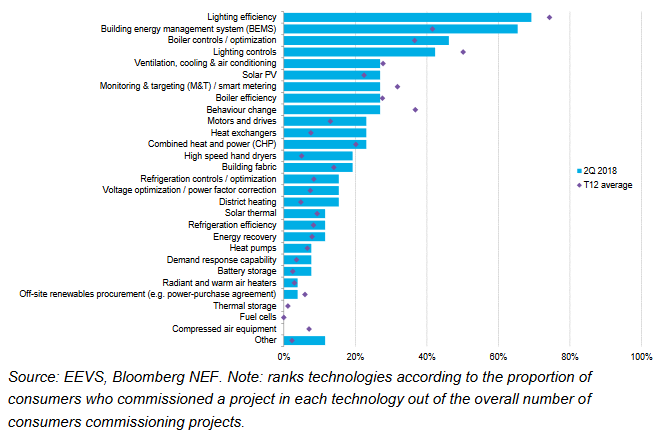by Brianna Crandall — October 3, 2018 — The Q2 2018 Energy Efficiency Trends report for the second quarter published recently by EEVS Insight and Bloomberg NEF (BNEF) reveals a surge in projects incorporating building energy management systems (BEMS) technology, closing the gap with long-running energy-efficiency technology favorite LED lighting.
In Q2 2018 the number of projects that included BEMS was 57% higher than the previous four-quarter average of 42%. Energy-efficient light-emitting diode (LED) lighting continues to be the dominant technology deployed, with 69% of respondents’ energy efficiency projects commissioned within Q2 including lighting technology (see graph below).

Uptake of energy efficiency technologies, Q2 2018 versus four-quarter average (Graphic courtesy EEVS)
According to the report, the rise in use of building energy management systems is part of an overall trend for smart building technologies, with 85% of active consumer respondents commissioning at least one of the following smart building technologies: building energy management systems, lighting controls, monitoring and targeting software or smart metering. During the same quarter, the uptake of projects including an emphasis on human behavior change dropped to 27% compared to a four-quarter average of 37%.
The popularity of BEMS technology seems particularly marked among larger organizations, with 94% of BEMS projects commissioned by organizations with more than 1,000 employees. Analysis of building type for BEMS implementation revealed projects were most prevalent among office buildings, accounting for 65% of BEMS projects, yet only 12% of manufacturing building types reported projects involving this technology.
Sam Stageman, sales director at APC Lighting, commented:
The increase in use of BEMS reflects our own experience in the commercial real estate marketplace as LED lighting solution providers. Once the preserve of cutting-edge, larger projects, we are now seeing the use of BEMS expand as companies seek to maximize ROI by using data to highlight opportunities for additional savings. By integrating our lighting systems into an organization’s BEMS, they can identify further lighting controls that can be put in place. What might have been a separate lighting control system in the past is made more user friendly when integrated with data on gas, electricity and energy usage from other processes such as cooling — providing a more complete picture.
In addition, the second quarterly report of 2018 revealed:
- Overall confidence, as shown within the report’s market barometer, rebounded sharply this quarter following an extended period of low and declining confidence. With suppliers in more positive mood, this step-change in confidence is also forecast to continue into Q3.
- Supplier orders enjoyed a welcome uptick this quarter, following a sustained 12‐month downward trend. 52% of suppliers saw orderbook growth in the last 3 months, with only 13% reporting declines.
- Among consumers surveyed, there was a significant uptick in customer spending this quarter, primarily driven by a jump in large-scale projects (£500k+). Accounting for 42% of projects, this was by far the strongest quarter for the largest schemes since the survey began.
Compiled from the results of a confidential, quarterly consumer and supplier survey, the UK Energy Efficiency Trends report evidences industry trends and has become one of the sector’s leading sources of market intelligence. The report is delivered by a research partnership between EEVS and Bloomberg NEF, and is supported by international law firm Bird & Bird, APC Lighting and the Environmental Industries Commission.
For detailed analysis of quarterly energy efficiency trends in the UK, view or download the full Energy Efficiency Trends Volume 24, Q2 2018 report from the EEVS website.




